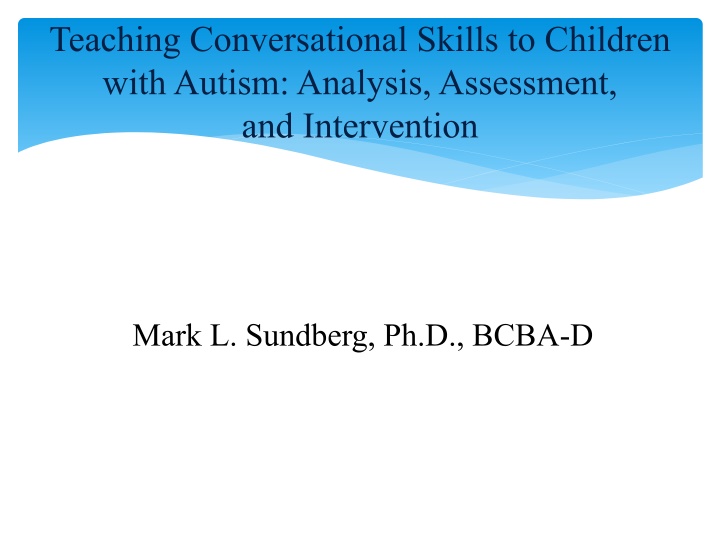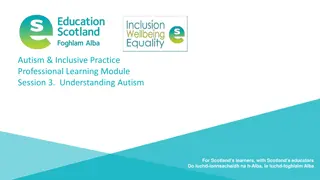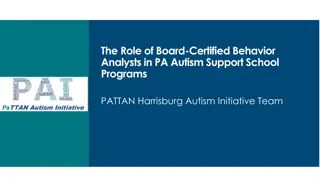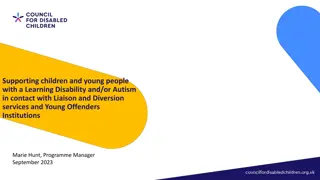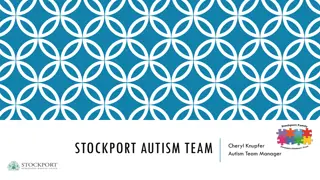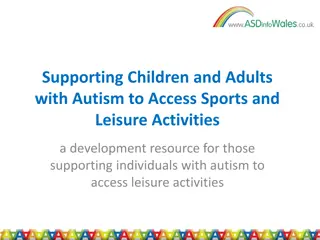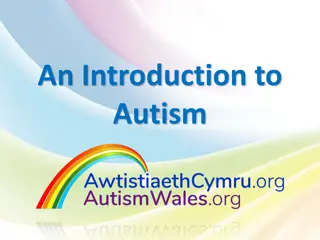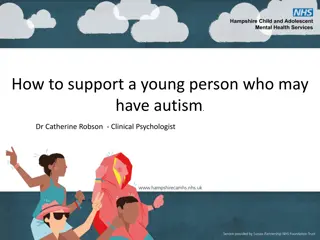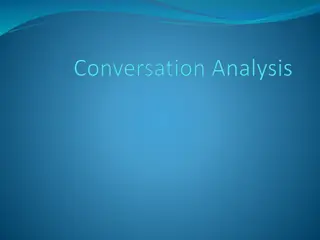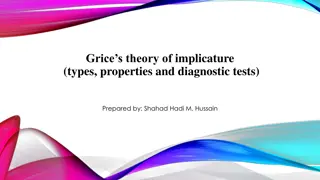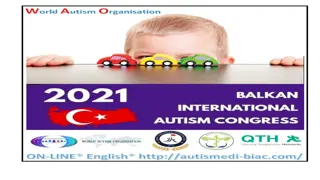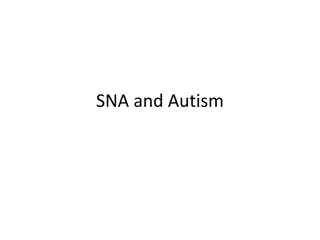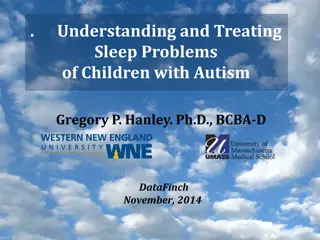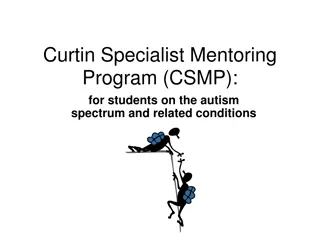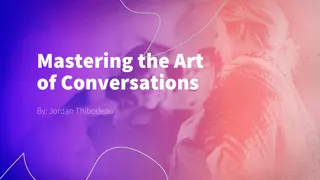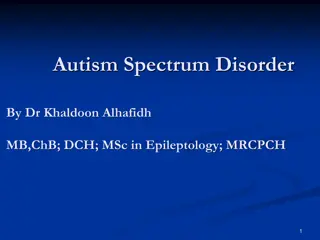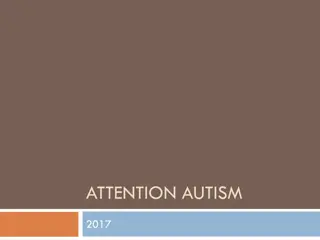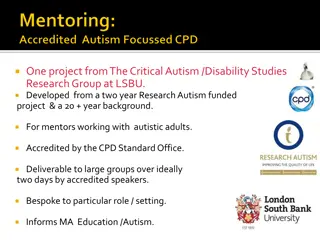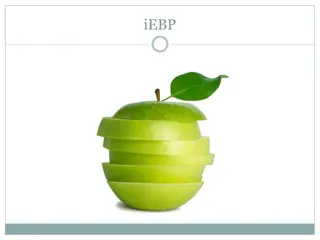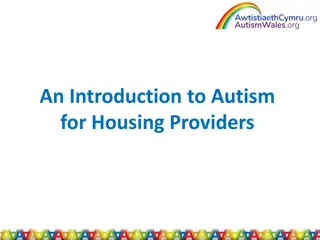Analyzing and Enhancing Conversational Skills in Children with Autism
This content provides an in-depth analysis of teaching conversational skills to children with autism, focusing on the challenges defined in the DSM-5 criteria and practical interventions. It explores the definition of conversation, failure indicators, and behavioral analysis insights into verbal interactions. Strategies and approaches are discussed to help children with autism develop effective communication skills.
Download Presentation

Please find below an Image/Link to download the presentation.
The content on the website is provided AS IS for your information and personal use only. It may not be sold, licensed, or shared on other websites without obtaining consent from the author.If you encounter any issues during the download, it is possible that the publisher has removed the file from their server.
You are allowed to download the files provided on this website for personal or commercial use, subject to the condition that they are used lawfully. All files are the property of their respective owners.
The content on the website is provided AS IS for your information and personal use only. It may not be sold, licensed, or shared on other websites without obtaining consent from the author.
E N D
Presentation Transcript
Teaching Conversational Skills to Children with Autism: Analysis, Assessment, and Intervention Mark L. Sundberg, Ph.D., BCBA-D
Conversation and the DSM-5 DSM-5: Persistent deficits in social communication and social interaction DSM-5: failure of normal back-and-forth conversation How do we teach those skills? How can behavior analysis help?
Looking for a Definition of a Conversation An oral exchange of sentiments, observations, opinions, or ideas (Merriam-Webster) The exchange of thoughts and feelings by means of speech or sign language (The Free Dictionary) A talk, especially an informal one, between two or more people, in which news and ideas are exchanged (Oxford Dictionary) No generally accepted definition of conversation exists.... (Wikipedia) Consequently, the term is often defined by what it is not (e.g., lectures, interviews, giving orders, testimonies, greetings, arguments) (Wikipedia)
What Constitutes Failure of normal back- and-forth conversation Elaboration of Failure of normal back-and-forth conversation by Laura Carpenter (a DSM-5 collaborator) Poor pragmatic/social use of language (e.g., does not clarify if not understood; does not provide background information) Does not initiate conversation One sided conversations/monologues/tangential speech What about the listener repertoires, the verbal content, its relevance to immediate variables, etc.?
A Behavioral Analysis of Conversation Guided by Skinner s (1957) Analysis of Verbal Behavior A conversation is a type of social behavior Specifically, a verbal interaction between a speaker and a listener, with the roles of each participant periodically reversing Each participant s behavior is controlled by 1) the previous speaker, 2) the immediate circumstances (including motivation), and 3) the speaker s and listener s histories (Palmer, 2014) ( Video: Phone conversation) Skinner (1957) terms a verbal interaction between a speaker and a listener a verbal episode (p. 38) In a verbal episode, a speaker emits any type of verbal behavior (e.g., mand, tact, intraverbal) in any form (e.g., speech, texting, eye contact) A listener reinforces a speaker s responses, but serves other roles (e.g., audience, provides reinforcement, becomes the next speaker)
The Behavior of the Speaker Antecedent Motivation (MO) Mand Nonverbal SD Verbal SD (w/ a match) Verbal SD (w/o a match) Behavior Consequence Specific reinforcement Generalized reinforcement Generalized reinforcement Tact Echoic Intraverbal Generalized reinforcement
The Behavior of the Listener The listener functions as an SDand MO for verbal behavior (audience) The listener reinforces and punishes a speaker s behavior The listener takes additional action, she emits behavior evoked by the previous speaker s verbal behavior Nonverbal respondent behavior (emotion) Nonverbal operant behavior ( receptive language ) Verbal operant behavior (listener becomes the next speaker) A speaker is also usually a listener of her own verbal behavior (thus, there are usually at least two listeners in a conversation)
Conversation: A Verbal Exchange Between Two People Speaker #1 Speaker #2 Speaker #1 Speaker #2 Initiator: Where do you live? Responder: On Elm St. Do you live around here? On Maple St. Do you want to come over? Yes, but I need to ask my mom
An Analysis of Starting a Conversation Convergent multiple control MO for social interaction Speaker #1 Initiator Speaker #2 Responder Peer attending (audience) Mand Intraverbal V SD Where do you live? On Elm St. MO for information Appropriate context Conditional discrimination (if-if-then)
A Mini Conversation: Three Verbal Episodes Divergent multiple control Convergent multiple control Convergent multiple control Convergent multiple control Tact/IV The blue house MO for social interaction MO for social interaction MO for social interaction Peer attending (audience) Peer attending (audience) Peer attending (audience) Intraverbal On Maple St Sr/ MC Sr/ Mand/IV Intraverbal S#2 Sr/V SD S#1 S#1 S#2 Sr/V SD ...... Do you live around here? V SD Where do you live? I live in a shoe On Elm St. Self as a listener MO for info. Approp. context Mand Do you want to come over? MO RE: humor; or history Approp. context Pressure to answer Approp. context Listener points to a house Conditional discrimination Conditional discrimination Novel stimuli and responses Conditional discrimination
Conversations Involve Multiple Variables Operating Between Speakers and Listeners Motivating operations (MOs) Verbal stimulus control (SDs) Nonverbal stimulus control (SDs) Multiple control (e.g., MOs, SDs, CSs, history, immediate context) Social behavior (verbal, listener, and nonverbal behaviors) Well established reinforcement history Prerequisite skills for advanced conversations (DSM-5) Complex types of discriminations (e.g., conditional discriminations) Must accommodate novelty Generative repertoires emerge
Applications: Assessment When is it appropriate to target conversational skills in an IEP? The primary focus for early learners (e.g., VB-MAPP Level 1) is on acquiring a basic verbal repertoire, and other supporting skills Once the component repertoires that participate in a conversation (e.g., attending, mands, tacts, intraverbals, listener discriminations) are established, a greater focus can be placed on conversations (VB-MAPP Level 2 & 3) Intervention priorities can be identified by a detailed assessment (the VB-MAPP), and the conversational skills demonstrated by typically developing children
Applications: Intervention Assessment results can determine priorities and guide the intervention A single verbal episode could be considered a conversation, and these skills are targeted from the beginning of a VB program Begin with the simple components of conversation (single echoic or mand exchange), build to more complex interactions (Video: Manding to peers) Target weak or impaired areas (MOs, intraverbal turn taking) Merge known verbal and listener skills into a conversation framework (e.g., use social games, activities, snack, arts and crafts, etc.) Natural environment training (NET) is more conducive to conversation, but a discrete trial format can be useful for establishing component skills (use a mixture of both formats) (videos)
Videos contributed by BACA staff: Lorna Fischer, M.A., BCBA Allison Ackerman, M.A. Jasenia Weathers www.thebaca.com
Jack and Avas Conversation Ava: Are you done? Jack: Wait. What do you think it is? Ava: A star? Jack: No. Ava: Is it a glow stick? Jack: No. Ava: Is it a mop? Jack: Yup, a mop.
Applications: Intervention Build to more complex and known variables, then add novel variables, varied topics, contexts, unpredictability, audiences, etc. Practice known and novel speaker-listener exchanges multiple times a day Develop intervention programs for existing barriers and deficits Develop a bank of conversation starters (e.g., video games, movies, brothers and sisters, sports, music, weather) Use modeling, video modeling, instructions, social stories, scripts, social games, behavioral skills training, PRT, role playing, etc. Reinforce approximations, make it fun
Conclusion Conversation is a complex type of social interaction, involving an verbal and nonverbal interaction between speakers and listeners Conversations involve multiple sources of control, (e.g., MOs, SDs, CS, the immediate context, private events, a specific reinforcement history), multiple behaviors (e.g., mands, tacts, attending reinforcing), etc. A behavioral analysis, along with Skinner s analysis of verbal behavior provides a guide for an individualized conversation assessment and intervention program As with other applications of ABA, better clinical outcomes for children with autism can be expected
Thank You! For more information on verbal behavior and links to additional material visit: www.marksundberg.com
Conversations Major aspect of human behavior Some are great conversationalists, others are not so good Large variations at similar intellectual, cognitive, and economic levels Multiple elements of a conversation Conversation can be especially difficult for those with autism Casual no set pattern of variables can t be easily scripted new topics at any moment not conducive to rote learning social event
